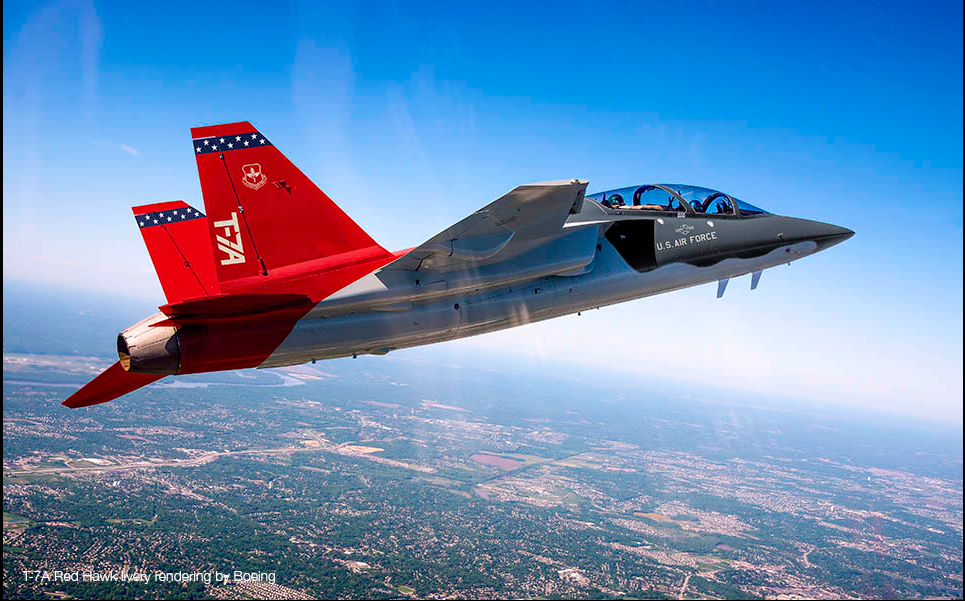
T-7A Red Hawk, Boeing image
WASHINGTON: Boeing is on track to deliver the first ground-based simulators for the T-7A Red Hawk trainer aircraft in 2023, launching production today of the first two weapon system trainers and the first operational flight trainer, the company says.
The Air Force has ordered 46 simulators and associated ground equipment but can purchase up to 120 simulators under the current contract, Boeing spokesperson Zeyad Maasarani said in an email.
Both types of Red Hawk ground-based training systems (GBTS) can be connected to live T-7A aircraft — designed and built by Boeing and Sweden’s Saab — and “participate in common embedded training scenarios,” Maasarani explained. “The aircraft and GBTS utilize a common debrief system which supports joint aircraft and simulator debrief sessions, allowing pilots to more quickly adjust and learn from their training.”
“The Red Hawk’s training system is arguably the most advanced in the world. It’s a game changer,” said Chuck Dabundo, vice president, Boeing T-7 Programs, said in the press release. “This system is 100% integrated with the pilot’s real-world experience, offering ‘real-as-it-gets’ simulation. We’re working closely with the U.S. Air Force and look forward to testing and fielding the devices.”
 The weapon system trainer (WST) has a 360-degree field of view visual system that can simulate using night-vision goggles, Boeing’s press release said. The operational flight trainer (OFT) has a 300-degree field of view. Both simulators have state-of-the-art, high-fidelity 8K native projectors to allow highly realistic visuals.
The weapon system trainer (WST) has a 360-degree field of view visual system that can simulate using night-vision goggles, Boeing’s press release said. The operational flight trainer (OFT) has a 300-degree field of view. Both simulators have state-of-the-art, high-fidelity 8K native projectors to allow highly realistic visuals.
“This is the most accurate, immersive experience that any pilot can have outside the cockpit,” Sherri Koehnemann, T-7A training & sustainment director at Boeing Global Services, said in the release.
As Breaking D readers know, Air Force Secretary Barbara Barrett has touted Boeing’s digital design and engineering as a model for future aircraft development, dubbing the first T-7A models built from their “digital twins” as the “e-T-7.”
The GBTS systems run on the same software as the T-7A aircraft, which means that when the plane is upgraded they can be too, Maasarani explained.
Further, the digital approach allows the “displays and handling qualities” to be “designed and purpose built” to meet customer requirements,” he said. “The flight control and mission systems are state-of-the art and can be adapted for a variety of aircraft and mission requirements.”
The Boeing-Saab team back in July responded to a request for information (RFI) from the Australian Defense Ministry, which is looking to replace the Royal Australian Air Force’s (RAAF) BAE Hawk 127 jet trainers. The current fleet of 33 trainers is used to prepare RAAF pilots to fly F/A-18A and F/A-18B Hornets and F/A-18F Super Hornets.
Further, the T-7A also could be used by some non-US Air Forces as a light-attack aircraft.
In addition to the flight simulators and the actual trainer aircraft, Maasarani noted, the Red Hawk’s “comprehensive training system includes interactive multimedia instruction, interactive classroom lessons, computer-based training modules, adaptive training that adjusts to students’ needs, and a complete suite of instructor tools – for optimum results on the ground and in the ‘classroom in the sky’.”






















